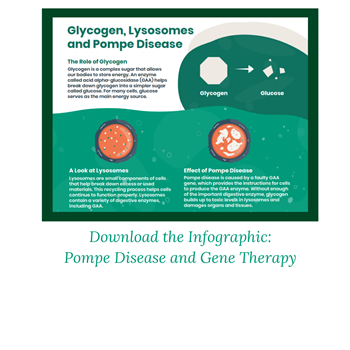Pompe disease occurs when the genes that instruct our cells to create the GAA enzyme are faulty. The GAA enzyme’s job is to break down complex molecules like glycogen, which is a substance that helps our body store energy. This process happens in small compartments of our cells called lysosomes, which help our body remove or recycle waste—including excess glycogen. Without enough GAA enzyme to break down glycogen, accumulation occurs and stops lysosomes from doing their important job. This can lead to a variety of symptoms including muscle weakness, difficulty breathing, and trouble gaining weight, along with eventual tissue damage and organ failure.
Pompe Disease and Gene Therapy
Gene therapy would deliver a functional version of the faulty gene into a cell, helping it produce the enzymes needed to break down glycogen. This delivery is accomplished using a vector, or vehicle, that contains the working gene. Vectors are often derived from viruses because they are capable of entering cells to deliver genetic material. However, all viral genes are removed and the vector is modified to only deliver therapeutic genes into cells. The goal of vectors is to deliver the functional genes to key organs like the liver, heart and brain. These organs are targeted because they produce the GAA enzymes that are needed throughout the body.

 There are both in vivo and ex vivo approaches being researched for Pompe disease. In vivo gene therapy means that the therapeutic vector is delivered inside the body. There is also an ex-vivo gene therapy treatment, which means that it takes place outside the body. A person’s stem cells would be removed from their body, and then a vector with the GAA gene would be delivered into the stem cells. Stem cells are versatile cells that can develop into different types of cells in the body, such as those in charge of creating GAA enzyme. These modified cells are then returned to the body via infusion and the new functional gene gives instructions to increase the amount of GAA enzyme to slow or stop symptoms of Pompe disease.
There are both in vivo and ex vivo approaches being researched for Pompe disease. In vivo gene therapy means that the therapeutic vector is delivered inside the body. There is also an ex-vivo gene therapy treatment, which means that it takes place outside the body. A person’s stem cells would be removed from their body, and then a vector with the GAA gene would be delivered into the stem cells. Stem cells are versatile cells that can develop into different types of cells in the body, such as those in charge of creating GAA enzyme. These modified cells are then returned to the body via infusion and the new functional gene gives instructions to increase the amount of GAA enzyme to slow or stop symptoms of Pompe disease.
Pathway to Treatment
Existing Treatments
Enzyme replacement therapy (ERT) for Pompe disease replaces the GAA enzyme through a vein infusion. ERT is used to treat a variety of genetic diseases. This treatment requires lifelong administration, which can be as often as every two weeks. The effectiveness of enzyme replacement therapy can also vary from person to person, based on age, severity of the disease, and additional medical needs. These variables will also apply to gene therapy once treatments enter clinical trials. For example, gene therapy may be less effective if the disease has progressed in a person’s body over time and has caused irreversible damage.
Treatment Pipeline
Investigational gene therapies for Pompe disease are currently showing promise in the preclinical study phase. This is a necessary step in research to establish safety and effectiveness in animals before proceeding with human testing. Research and development of these therapies is being done by companies such as Avrobio, Spark, Astellas Gene Therapies (formerly Audentes), Amicus, Actus, Genethon, and Sarepta Therapeutics.
To stay up to date on active and recruiting clinical trials that may become available in the U.S. or globally, visit ClinicalTrials.gov or the Gene Therapy Trial Browser.
Availability
People with Pompe disease cannot participate in clinical trials for gene therapy yet. Gene therapy for infantile Pompe disease is currently in the early stages of research, also known as preclinical studies. This is a necessary research phase that helps to establish the safety and effectiveness of a treatment before proceeding with human testing. The faster and more severe progression of the disease in infantile patients allows better ways for researchers to evaluate the efficiency of treatment, as opposed to late onset version of the disease which moves slower. When human clinical trials begin to show promise, the hope would be to expand the indication for gene therapy to also include late onset.
Get Involved
Getting involved with patient advocacy organizations is a great way to connect with other families and patients affected by Pompe disease, gather useful resources, and advocate for research. The diseases may be rare, but you're not alone.